My Favorite Image

American Soldiers as Victims in Vietnam
David Parsons, The Graduate Center, City University of New York
David Parsons uses Arthur Greenspon’s 1968 photograph of a U.S. Army paratrooper in Vietnam to explore the different versions of history that have been presented to the public since 1968.

Riis Redux: Seeing the Light
Vincent DiGirolamo, Baruch College, City University of New York
Jacob A. Riis’ photographs of New York’s lower east side at the turn of the twentieth century have become iconic images of immigrant poverty. Historian Vincent DiGirolamo uses them to teach students to look and think harder about photography as a tool of social reform.

Imaging Americans
Shawn Michelle Smith, School of the Art Institute of Chicago
Shawn Michelle Smith discusses Frances Benjamin Johnston’s photograph of Whittier primary school students as a historical inquiry into African-American education, citizenship, “uplift” campaigns, and visual propaganda.

Two Photos, Many Stories
William Friedheim, Borough of Manhattan Community College
Historian William Friedheim uses before and after photographs of Lakota students taken at the Carlisle Indian School to raise issues about Native American identity and assimilation, and demonstrates how examining photographs as primary documents, combined with additional primary sources, shows students how use of evidence creates historical meaning.

Thomas Eakins, The Champion Single Sculls, 1871
Ian Gordon, National University of Singapore
In this essay, historian Ian Gordon describes how he uses Thomas Eakins’s painting The Champion Single Sculls to explore America’s cultural and economic transition to modernity in the late-nineteenth century.

Irish Immigrant Stereotypes and American Racism
Kevin Kenny, Boston College
In this essay, Kevin Kenny examines a British political cartoon to raise questions about the transatlantic nature of anti-Irish prejudice and its relationship to the history of racism in America.

John Gast, American Progress, 1872
Martha A. Sandweiss, Amherst College
Historian Martha A. Sandweiss demonstrates how John Gast’s 1872 painting, which was widely disseminated as a commercial color print, conveys a range of ideas about the frontier in nineteenth-century America.

Eastman Johnson, A Ride for Liberty—The Fugitive Slaves, c. 1862
Donna Thompson Ray, The Graduate Center, City University of New York
Eastman Johnson’s painting of fugitive slaves helps address ways to teach a pivotal question in U.S. history: Did Lincoln free the slaves—or did the slaves free themselves?

Timothy O’Sullivan, Historic Spanish Record of the Conquest, 1873
Elizabeth Hutchinson, Barnard College
This image of an inscribed rock raises questions about the Spanish conquest of the American Southwest, post-Civil War western expansion, and the Frontier Thesis.

Thomas Nast, Milk Tickets for Babies, 1876
Michael O'Malley, George Mason University
Michael O’Malley explains how Thomas Nast’s 1876 political cartoon lampooning paper money provides an opportunity for students to explore public debate about economic transformations during the Gilded Age.
